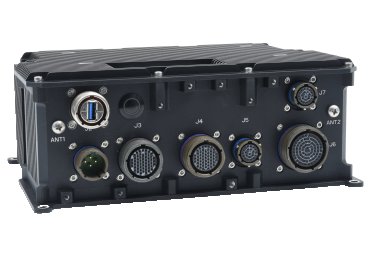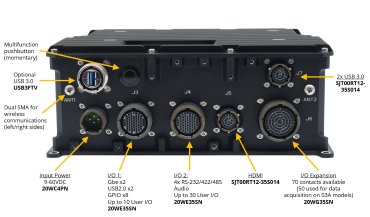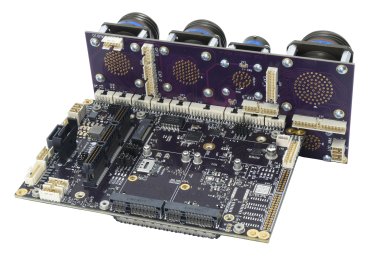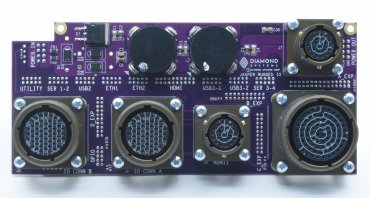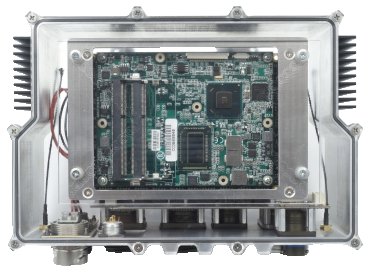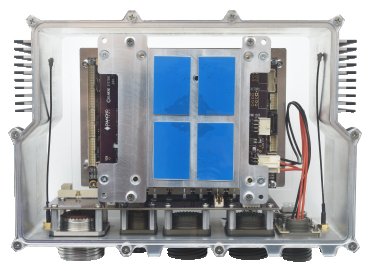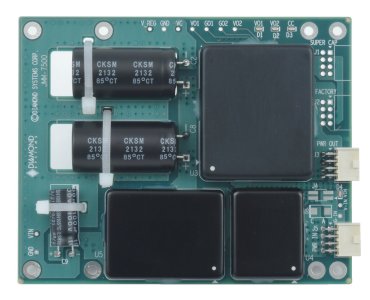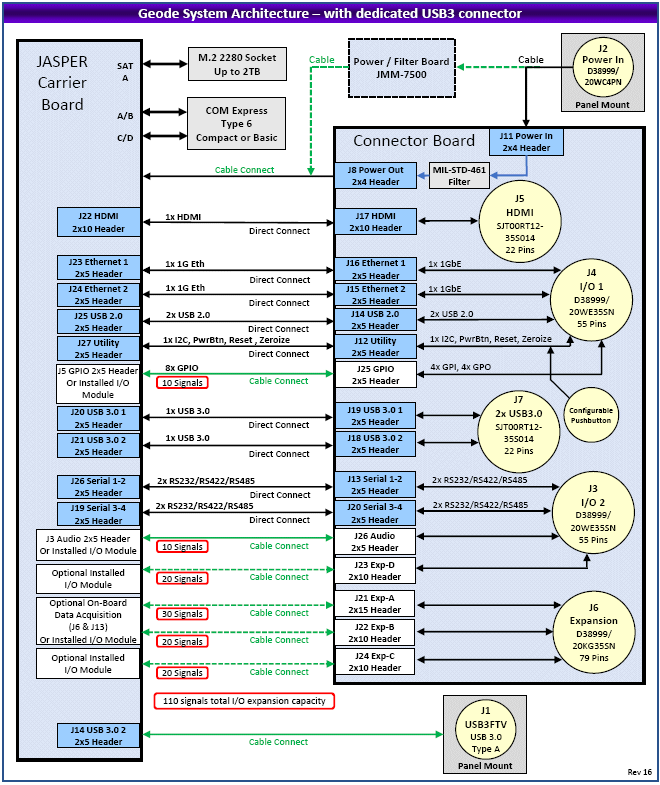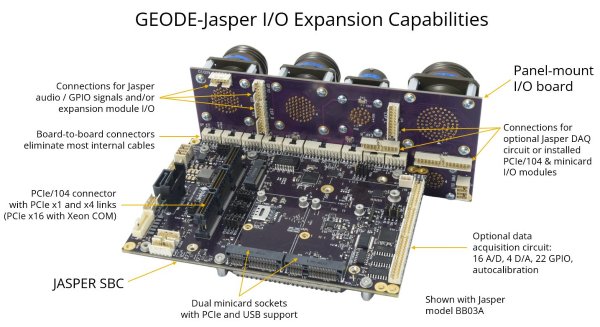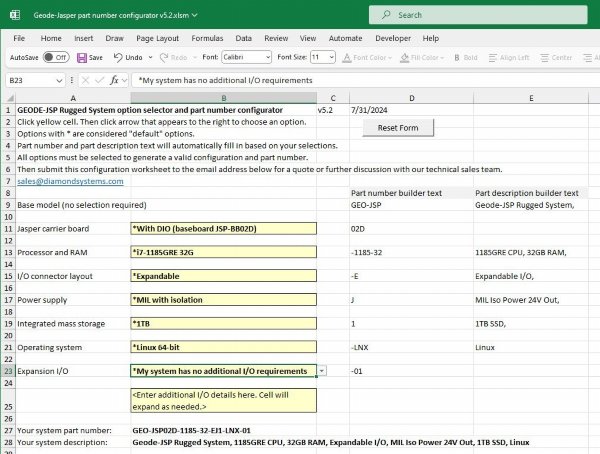The GEODE rugged computer system platform offers easy customization and quick availability for rugged computers due to its novel architecture that includes pre-integrated expansion connectors for easy addition of I/O, plus the use of COM Express modules to support flexible CPU choices. In addition to the standard computer I/O features, GEODE supports up to 3 I/O boards with up to 110 additional I/O signals without requiring any change to the enclosure or cabling. The elimination of custom enclosure and cabling design efforts dramatically reduces up-front costs and delivery times, and the resulting use of common components across multiple product configurations helps keep production costs down and facilitates the production of small quantities for pilot or small-run programs. The COM is thermally coupled to the top surface of the enclosure with a conduction cooling heat spreader and mounting plate. (Heat spreader removed for illustration purposes, normally present in the open rectangle in the mounting plate) |
| |
The optional filtered 80-watt power supply is thermally coupled to the bottom surface of the enclosure using a conduction cooling mounting plate with thermal pads on both sides. |
| |
The entire system is housed in a rugged 3-part enclosure that eliminates all T joints and includes seals at all joints to ensure IP67 compliance. |
| |
GEODE is based on Diamond's JASPER COM Express carrier board featuring a high level of I/O as well as multiple sockets for I/O expansion. The optional integrated data acquisition circuit provides high-accuracy analog I/O with autocalibration and programming library support. Dual minicard sockets and a PCIe/104 socket with PCIe x1 and x16 links (depending on the installed COM) enable feature upgrade with the widest range of I/O modules, from low-cost minicards up to high-performance graphics and 10Gb Ethernet, all without modifying the case or cables. Diamond's JMM-7500 MIL-grade rugged power supply with MIL-STD-461, -704, and -1275 compatibility and 9-60VDC range. The supply is available with both isolated and non-isolated output configurations. As a cost and weight reduction alternative, a MIL-STD-461 filter circuit is built right into the connector board, eliminating the separate power supply for applications where 461 filtering alone is sufficient. Both the processor and power supply are direct-coupled to the enclosure for efficient conduction cooling. |
| |
 |
Block
Diagram |
 |
Mass Storage and
I/O Expansion |
 |
Mass Storage and I/O Expansion |
Mass storage is provided by an M.2 2242/2280 size solid-state disk module with capacity up to 2TB. Additional storage can be provided with an add-on drive using the built-in SATA connector. I/O expansion is readily accomplished with the use of PCIe / USB minicards as well as PCIe/104 I/O modules. The PCIe/104 socket supports up to 4 x1 links and 1 x16 link, depending on the installed COM. A Core i7 or lower performance COM will typically support 3-4 PCIe x1 links. A Xeon or higher COM will typically support the x1 links as well as the x16 link. | Slide Id Jasper callouts not found |
 |
Direct-Coupled Connector Board Eliminates Cables |
Internal cables are a leading cost, leadtime, and size driver for rugged systems, as well as usually the most failure-prone element in the design. With Geode, most I/O connectors are mounted on a circuit board that plugs directly into the main computer board and eliminates most internal cables. This design reduces cost, reduces failure, reduces size, increases ruggedness, and simplifies assembly. Attachment points are provided for optional dust caps for all connectors. The rightmost connector is on a breakaway portion of the circuit board and can be removed to support smaller systems that have lesser I/O requirements. 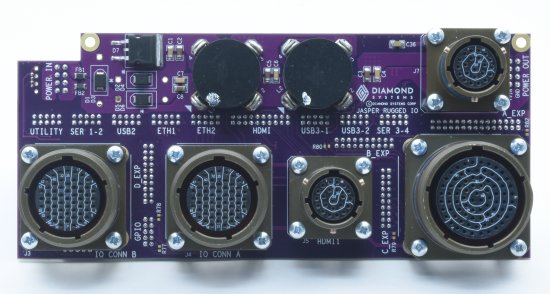 | | | Outward face with MIL-DTL-38999 style connectors |
|
The total number of flexible I/O expansion pins on Geode-JSP is 110. These are provided in multiple ways to enable maximum flexibility in external wiring.
One front panel I/O connector (J6) is reserved for internal cable connection to allow easy I/O expansion without redesigning the enclosure. J6 is accessed internally with 3 latching pin headers: 2 20-pin and 1 30-pin (total 70 I/O signals available). On models with data acquisition, the 30-pin and one 20-pin connector are connected to the DAQ circuit on the Jasper SBC, and the second 20-pin connector remains available.
Another 20-pin internal connector is available leading to 20 unused pins on I/O connector J3. This can be used to combine custom I/O with existing system I/O to reduce the number of external cables needed.
Two additional 10-pin internal connectors support up to 20 additional I/O signals. These connectors are normally tied to the GPIO and Audio signals on J4 and J3 respectively, but they can be repurposed by removing the internal patch cables and connecting expansion boards to them instead.
 |
How to Order |
Geode-JSP has a large number of standard configuration options. You can also customize it to add more I/O or make other changes. All the standard options are shown in our configuration worksheet. You can download the worksheet, fill it in, and submit it to us to request a quote.
Available options include:
- Data acquisition
- Choice of processor and RAM capacity
- Expansion I/O connector
- Integrated power supply
- Integrated SSD
- Operating system (Windows 10 / Ubuntu Linux)
- Custom I/O using PCIe minicard and PCIe104 modules
| 


